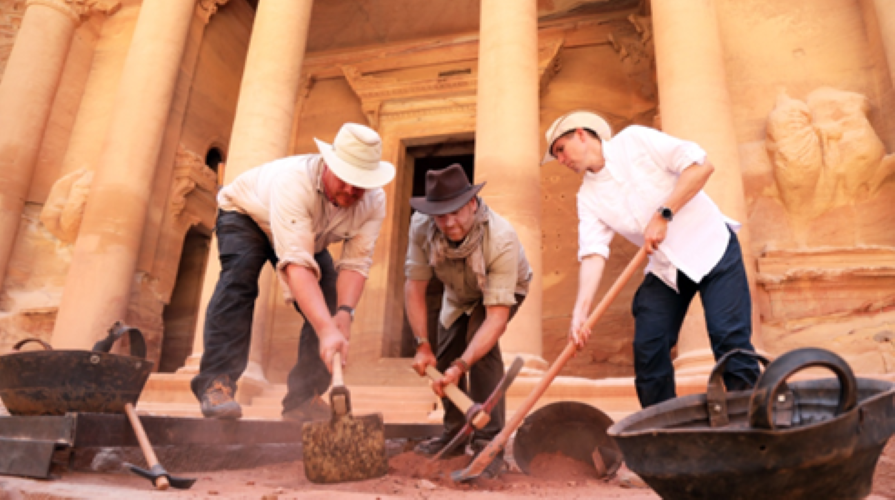
A ground-breaking discovery of a secret tomb at one of the new seven wonders of the world has been made by a team of researchers, including academics from the University of St Andrews.
Professor Richard Bates, from the St Andrews School of Earth and Environmental Science, was part of a collaboration carrying out research at Al-Khazneh, the Treasury Building, at the World Heritage Site of Petra, Jordan.
The team found a long-buried tomb with the remains of 12 ancient skeletons beneath the iconic building where more than a million visitors a year come to visit and the unexpected discovery now features in a new Discovery Channel documentary.
A project was a collaboration between the Jordanian Department of Antiquities (DoA), Petra Development and Tourism Region Authority (PDTRA), the American Center of Research (ACOR), the University of St Andrews, and the Discovery Channel.
The ground-breaking and historic excavation is revealed in Excavation Unknown, a two-part programme aired this month on Discovery Channel with adventurer Josh Gates.
The Treasury sits as the centre of an entire city carved by hand into the walls of a desert canyon by the people of the Nabatean Kingdom, 2000 years ago. Famous as the cinematic resting place of the Holy Grail in Indiana Jones and the Last Crusade, the true purpose of the Treasury remains a mystery.
The team were given permission to conduct a remote sensing scan and then dig beneath the Treasury. Professor Bates began this new investigation by conducting remote sensing in and around the Treasury. The non-invasive survey was conducted with electromagnetic conductivity and ground penetrating radar.
Professor Bates said: "The main purpose of the survey was to assess the condition of the areas around the Treasury, its courtyard, the plaza, exit of the Siq and the wadi into which they all feed, in advance of potential future works to divert and better control flood waters."
When the survey found probable underground chambers in and around the Treasury, an excavation plan was designed and carried out by a team from the Department of Antiquities and ACOR. This revealed the presence of a tomb, with burials still in their ancient locations.
Professor Bates said: "The discovery is of international significance as very few complete burials from the early Nabataeans have ever been recovered from Petra before. The burials, their goods, and the human remains can all be expected to help fill the gaps of our knowledge in how Petra came to be and who the Nabaraenas were."
Dr Tim Kinnaird from the University of St Andrews School of Earth and Environmental Sciences was brought in to sample and date the sediment surrounding the burials and also to sample material from the tomb enclosure. This information provided crucial dates for construction of the walls within the tomb of mid 1st century BC to early 2nd century AD.
Dr Kinnaird said: "The tomb was most likely built as a mausoleum and crypt in the Nabatean Kingdom at the beginning of the 1st century AD for Aretas IV Philopatris. Like many tombs in the valley, few remains have ever been found in the tombs due to their subsequent use and reuse over the last two millennia.
"Its fantastic that we now have the pottery, ecofacts and sediments to date when the treasury was constructed. Previously we've worked on assumptions and conjectures – to have a definitive date will be a monumental achievement for us all."
One skeleton in the chamber was found clutching a ceramic vessel.
Adventurer and presenter Josh Gates said: "When we spotted what looked like a chalice, all of us just froze. It looked nearly identical to the Holy Grail featured in Indiana Jones and the Last Crusade, set in the ancient building directly above the tomb. It was the ultimate moment of life imitating art."
Detailed examination of the vessel reveals it to be the top part of a broken jug, likely dating to the first century BC.
Professor Bates said: "It was an incredible privilege to be able to survey at such an iconic site and to have the geophysics verified with an excavation so soon is a rare opportunity. The extent of the discovery was so unexpected but will likely shed light on not only the Treasury building but also on the whole of the Nabatean society.'
Archaeologist Pearce Paul Creasman, Executive Director of ACOR, said: "There is so much that we have yet to learn about The Treasury. When was this remarkable structure built, and why? Little did we know that this dig might completely change what we know about The Treasury and help solve the mysteries of the Nabataean people. With the support of the Jordanian government, this excavation is bringing us closer than ever to answers."
Category Research






